SpaceX delivers inflatable room that could be future of Mars exploration to International Space Station

Your support helps us to tell the story
From reproductive rights to climate change to Big Tech, The Independent is on the ground when the story is developing. Whether it's investigating the financials of Elon Musk's pro-Trump PAC or producing our latest documentary, 'The A Word', which shines a light on the American women fighting for reproductive rights, we know how important it is to parse out the facts from the messaging.
At such a critical moment in US history, we need reporters on the ground. Your donation allows us to keep sending journalists to speak to both sides of the story.
The Independent is trusted by Americans across the entire political spectrum. And unlike many other quality news outlets, we choose not to lock Americans out of our reporting and analysis with paywalls. We believe quality journalism should be available to everyone, paid for by those who can afford it.
Your support makes all the difference.SpaceX has delivered an inflatable bedroom for astronauts to the International Space Station.
The soft compartment is the first of its kind to go into space. But it could be far from the last: its makers hope that it will allow for inflatable habits on Mars, revolutionising the way that astronauts live on space.
The company that made the small room, Bigelow Aerospace, hopes that within four years it can launch inflatable space stations made with the same technology that can then be leased out to commercial companies.
The Bigelow Expandable Activity Module — BEAM for short — is able to be packed into much smaller spaces than traditional habitats. The room that went up to the ISS was packed tightly — but when it is blown up it will be as big as a small bedroom.
The inflatable room arrived on a SpaceX Dragon cargo ship that arrived at the International Space Station over the weekend. It was grabbed by a robotic arm on board the station.
It will soon be attached to the space station, before it gets inflated in May. But it will mostly go left untouched by the six-man ISS crew while it is being tested, apart from occasional trips to take measurements and swap sensors.
The delivery is the first that SpaceX has made for Nasa since a launch accident last year. Since June, the company has stopped its usual business of transporting supplies on the two-day, 250-mile journey to the ISS.
That meant that SpaceX headquarters was especially excited when the robot arm caught the Dragon capsule and attached it to the station.
"It looks like we caught a Dragon," announced British astronaut Timothy Peake, who made the grab. "There are smiles all around here," NASA's Mission Control replied. "Nice job capturing that Dragon."
That success was even more notable given that the company had landed its booster on a floating platform for the first time. The company has been trying repeatedly to do so — a move that will allow it to make re-usable rockets and make substantial savings on missions — but has been plagued by problems including the rockets falling over on landing.
Join our commenting forum
Join thought-provoking conversations, follow other Independent readers and see their replies
Comments